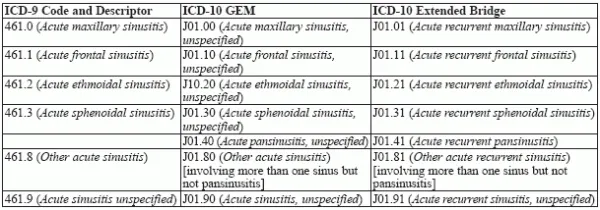Encourage Physicians to Document 'Recurrent' for Future Acute Sinusitis Diagnoses
General descriptors for 461 code family make a straightforward shift.
With a new focus on acute sinusitis thanks to additional PQRS measures for 2014, you’ll want to be sure you handle diagnosis coding correctly.
Current coding: ICD-9 includes choices specific to the sinuses affected (frontal, maxillary, ethmoidal, sphenoidal, unspecified, or other). Each has its own code under diagnosis family 461 (Acute sinusitis), designated by the fourth digit. For example, you submit 461.1 for acute frontal sinusitis or 461.2 for acute ethmoidal sinusitis.
ICD-10 updates: Acute sinusitis descriptors remain essentially the same in ICD-10 with extended codes to qualify “acute recurrent sinusitis” added to the range of codes. The following chart outlines the current codes along with ICD-10 General Equivalency Mappings (GEMs) and extended bridges.
Coding tips: Your physician should already be accustomed to noting the affected sinus when he diagnoses acute sinusitis. The biggest difference when ICD-10 becomes effective in October is that he’ll need to also document whether the condition is recurrent. The “unspecified” category for each sinus includes not recurrent as well as not specified as recurrent. Knowing that the acute sinusitis is recurrent will help you assign a more accurate code rather than resorting to “unspecified” for the affected sinus being coded.

